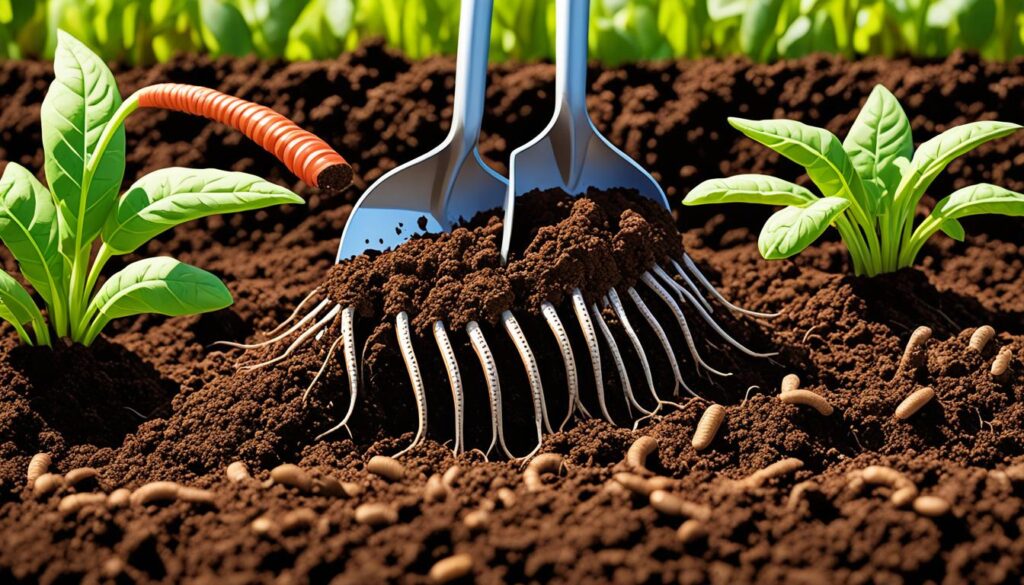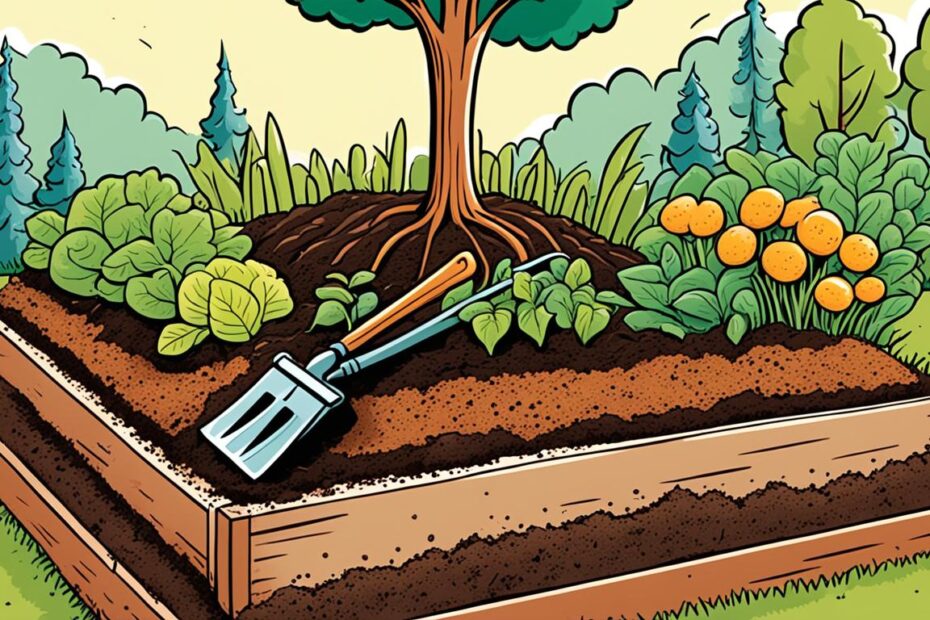Do you want to unlock the full potential of your garden or farm? Are you ready to take your soil to the next level? The key lies in cultivating fertile land through effective soil building techniques. But how exactly can you build soil effectively? Is there a secret formula to creating healthy and nutrient-rich soil? Let’s delve into the world of permaculture and regenerative agriculture to uncover the answers.
Key Takeaways:
- Soil building is crucial for regenerative land stewardship and the success of permaculture and regenerative agriculture practices.
- Healthy soil with nutrients, organic matter, and beneficial microorganisms is essential for supporting robust plant growth and a thriving ecosystem.
- Understanding the importance of healthy soil is crucial for implementing effective soil building techniques.
- Soil building techniques differ for annual gardens, grasslands, and food forests, but all focus on minimizing soil disturbance and enhancing organic matter.
- Organic soil amendments like compost, manure, cover crops, and natural fertilizers play a vital role in building and maintaining soil fertility.
The Importance of Healthy Soil
Healthy soil is the foundation for successful gardening and farming. It provides essential nutrients, supports microbial activity, and improves plant health and productivity. Healthy soil also helps with water infiltration and retention, prevents erosion, and contributes to overall ecosystem health. Understanding the importance of healthy soil is essential for implementing effective soil building techniques.
“Healthy soil is not just dirt; it’s a living ecosystem that sustains life.”
When soil is healthy, it creates an optimal environment for plants to thrive. It contains a balanced mix of organic matter, minerals, air, and water. This ideal soil composition allows plant roots to easily access nutrients, promotes root growth, and enhances nutrient uptake. As a result, plants become more resilient to pests, diseases, and environmental stresses.
One of the key aspects of healthy soil is its ability to support microbial activity. Beneficial microorganisms, such as bacteria and fungi, play a crucial role in breaking down organic matter, converting nutrients into forms that plants can absorb, and improving soil structure. These microorganisms also help suppress harmful pathogens and aid in the decomposition of organic materials, replenishing nutrient levels in the soil.
Moreover, healthy soil has excellent water infiltration and retention capabilities. It allows rainwater or irrigation to penetrate deeply into the ground, reducing surface runoff and preventing water wastage. By holding adequate moisture, healthy soil ensures plants have a constant water supply even during dry periods. This water regulation also helps prevent soil erosion by keeping the soil particles intact and bound together.
Benefits of Healthy Soil:
- Enhanced plant growth and productivity
- Increased nutrient availability
- Improved water infiltration and retention
- Reduced soil erosion
- Enhanced microbial activity and nutrient cycling
- Increase in soil organic matter
By recognizing the importance of healthy soil, gardeners and farmers can implement effective soil building techniques to improve their soil quality. With the right practices, they can create a thriving ecosystem that supports sustainable food production, protects the environment, and ensures the long-term viability of their land.
Soil Building for Annual Gardens
Creating a fertile soil foundation for your annual gardens is key to ensuring the healthy growth of your crops. By implementing specific soil building techniques, you can enhance the productivity and vitality of your garden. To build soil effectively for annual gardens, follow these essential practices:
1. Avoid deep tilling: Deep tilling and disturbing the subsoil can disrupt the natural soil structure. Instead, focus on biological tillage by encouraging earthworms and other beneficial soil organisms. They help aerate the soil and improve its overall structure.
2. Add compost: Incorporating compost into your garden beds is crucial for providing organic matter and beneficial soil microorganisms. Compost enriches the soil with essential nutrients, improves water-holding capacity, and enhances microbial activity.
3. Maintain organic matter with mulch: Mulching your annual garden beds helps retain moisture, suppresses weeds, and protects the soil structure. Organic mulch, such as straw or shredded leaves, gradually decomposes and adds to the organic matter content of the soil.
4. Implement crop rotation: Rotating the type of crops you plant each year helps mimic natural diversity and promotes healthier soil. Different crops have varying nutrient requirements, and rotating them helps prevent nutrient depletion and reduces the risk of pest and disease buildup.
By applying these soil building techniques, you can cultivate a nutrient-rich soil environment that nourishes your annual crops and supports their optimal growth.

| Benefit | Technique |
|---|---|
| Aerates the soil | Encouraging earthworms and beneficial soil organisms |
| Increases nutrient availability | Adding compost |
| Improves water retention | Maintaining organic matter with mulch |
| Enhances soil fertility | Implementing crop rotation |
Soil Building for Grasslands
When it comes to grasslands, the soil building techniques differ from those used in annual gardens. Building and maintaining healthy soil in grasslands is essential for supporting the growth of native grasses and maintaining the integrity of this unique ecosystem.
One of the key principles in building soil for grasslands is to minimize soil disturbance. Avoid deep tilling, as it disrupts the natural soil structure and can lead to erosion. Instead, focus on practices that promote no-till and no compaction.
To protect and improve soil structure in grasslands, it is important to keep the soil covered with perennial cover crops. These plants act as living mulch, preventing erosion and providing organic matter as they decompose. By mimicking the diversity found in native grassland ecosystems, planting a variety of perennial cover crops also optimizes solar energy collection and nutrient cycling.
Animal impact and planned grazing are another way to incorporate planned disturbance into grasslands and contribute to soil building. Grazing animals help break up compacted soil, trample plant material, and deposit organic matter in the form of manure. This process enhances the nutrient cycling and stimulates microbial activity, ultimately improving soil health.
By implementing these soil building techniques, you can create a thriving grassland ecosystem that supports the growth of native grasses and contributes to the overall health of the land.
Soil Building Techniques for Grasslands
| Technique | Description |
|---|---|
| No-till and no compaction | Minimize soil disturbance to preserve soil structure and prevent erosion. |
| Perennial cover crops | Keep the soil covered with a variety of perennial plants to protect and enrich the soil. |
| Plant diversity | Mimic the diversity of native grassland ecosystems by planting different types of perennial cover crops. |
| Animal impact and planned grazing | Introduce grazing animals to stimulate soil biological activity and contribute to nutrient cycling. |
Soil Building for Food Forests
Food forests are a remarkable way to create a self-fertilizing ecosystem that mimics the diversity and resilience of natural forests. To build healthy soil in food forests, you need to establish a strong foundation and minimize mechanical disturbance. By following these soil building strategies, you can create the ideal conditions for abundance and sustainability in your food forest.
The Key Ingredients:
- Perennial Cover: Planting a diverse array of perennial cover crops is essential in food forests. These plants protect and enrich the soil, optimize nutrient cycling, and provide habitat for beneficial insects and microorganisms.
- Organic Matter: Compost, nature’s black gold, is a powerful soil amendment that nourishes food forest soil. Use compost to add organic matter, improve soil structure, and enhance fertility. The rich microbial life in compost helps break down organic matter, making nutrients more available to plants.
- Diversity: Food forests thrive on diversity. By incorporating a wide range of plant species, you create a balanced and resilient ecosystem. This diversity promotes symbiotic relationships, nutrient sharing, and natural pest control.
Careful Management:
To maintain the delicate balance of a food forest, it’s important to minimize disruption and adopt management practices that support soil building:
- Avoid Tilling: Unlike traditional gardens, food forests benefit from minimal soil disturbance. Tilling can disrupt the ecosystem and harm beneficial organisms. Embrace no-till or low-till methods to preserve soil structure and promote mycorrhizal networks.
- Planned Animal Impact: Animals play a vital role in building healthy soil. Controlled grazing and animal impact can simulate natural processes, cycling nutrients, and improving soil structure. Consider integrating chickens, goats, or other livestock in your food forest to have a positive impact on soil health.
- Mulching: Apply a layer of organic mulch around your food forest plants. Mulch suppresses weeds, retains moisture, moderates soil temperature, and provides a slow release of nutrients as it breaks down. It also creates a favorable environment for beneficial soil organisms, contributing to soil fertility.
Achieving Harmony:
Building nutrient-rich soil in food forests requires a holistic approach that aligns with the natural processes of a forest ecosystem. By establishing perennial cover, utilizing compost and organic matter, promoting diversity, and implementing thoughtful management techniques, you can create a thriving food forest that supports abundant harvests, fosters biodiversity, and inspires ecological harmony.

Organic Soil Amendments
Building and maintaining soil fertility is essential for successful gardening and sustainable farming practices. Organic soil amendments, such as compost, manure, cover crops, and non-synthetic fertilizers, play a vital role in enriching the soil with nutrients and promoting beneficial microbial activity.
The Benefits of Organic Soil Amendments
- Compost: Compost is a valuable source of organic matter, providing essential nutrients and improving soil structure. It enhances water retention and drainage, promotes aeration, and fosters the growth of beneficial soil microorganisms.
- Manure: Livestock manure is a powerful organic amendment that adds nutrients, organic matter, and microbial life to the soil. It helps improve soil fertility and structure, increasing nutrient availability for plants.
- Cover Crops: Cover crops serve multiple purposes in soil building. They add organic matter to the soil as they decompose, improving soil structure and nutrient content. Cover crops also suppress weeds, prevent erosion, and enhance soil biodiversity.
- Non-Synthetic Fertilizers: Using organic fertilizers derived from natural sources, such as bone meal, fish emulsion, or kelp meal, helps replenish essential nutrients in the soil. These non-synthetic fertilizers are slow-release, providing a steady supply of nutrients to plants over time.
Using Organic Soil Amendments Effectively
“Organic soil amendments are like a boost of life for your soil. They invigorate it with vital nutrients and microorganisms, creating an environment where plants can thrive and nourish you with abundant harvests.” – Organic Gardening Expert
When applying organic soil amendments, it’s essential to consider the specific needs of your plants and the current state of your soil. Conducting soil tests can help determine nutrient deficiencies and guide the selection and application of amendments.
Here’s a simple guide to using organic soil amendments effectively:
- Compost: Spread a layer of compost over the soil surface and incorporate it into the top few inches. For established plants, apply compost as a side dressing around the base.
- Manure: Apply well-aged manure to the soil, ensuring it is fully composted to prevent burning or nutrient imbalances. Work it into the soil or use it as a topdressing.
- Cover Crops: Plant cover crops during fallow periods or before planting crops. Allow them to grow and then incorporate them into the soil before they go to seed.
- Non-Synthetic Fertilizers: Follow the recommended application rates provided by the manufacturer. Apply the fertilizer evenly to the soil surface and water it in thoroughly.
A Holistic Approach to Soil Health
Remember, healthy soil goes beyond the use of organic soil amendments alone. It is crucial to adopt a holistic approach to soil health that includes practices like crop rotation, mulching, companion planting, and minimizing soil disturbance. These practices work synergistically with organic soil amendments to create a thriving, sustainable ecosystem in your garden or farm.
| Organic Soil Amendment | Key Benefits |
|---|---|
| Compost | Rich in organic matter and nutrients, enhances soil structure, improves water retention, and supports microbial activity. |
| Manure | Provides organic matter, nutrients, and beneficial microbes, improves soil fertility, and enhances nutrient availability. |
| Cover Crops | Adds organic matter, suppresses weeds, prevents erosion, improves soil structure, and increases soil biodiversity. |
| Non-Synthetic Fertilizers | Derived from natural sources, replenishes essential nutrients, promotes healthy plant growth, and improves nutrient availability. |
Conclusion
Building soil effectively is the key to cultivating fertile land and maximizing the success of your gardening and farming practices. By implementing permaculture principles and utilizing organic soil amendments, such as compost, manure, and cover crops, you can significantly improve soil health, fertility, and structure.
Take inspiration from natural ecosystems and strive to mimic their diversity and resilience. By optimizing soil biology and nurturing beneficial microorganisms, you can unlock the full potential of your land. This approach will create a thriving ecosystem that supports healthy plant growth and sustainable food production.
Remember, the journey to building healthy soil is a long-term commitment. Regularly add organic soil amendments and practice soil-building techniques that promote minimal disturbance. By incorporating these practices into your gardening and farming routines, you can create an environment that nourishes both the soil and your crops, resulting in bountiful harvests for years to come. Start building your soil effectively today and reap the rewards of a fertile and productive land.
FAQ
Why is healthy soil important for gardening and farming?
Healthy soil provides essential nutrients, supports microbial activity, improves plant health and productivity, aids in water infiltration and retention, prevents erosion, and contributes to overall ecosystem health.
What specific soil building techniques are recommended for annual gardens?
In annual gardens, it is important to avoid deep tilling and disturbance of the subsoil. Instead, focus on biological tillage by encouraging earthworms and other soil organisms. Adding compost, maintaining organic matter with mulch, and practicing crop rotation to mimic diversity are essential soil building techniques for annual gardens.
What soil building techniques are recommended for grasslands?
To build healthy soil in grasslands, minimize soil disturbance and avoid compaction. Keeping the soil covered with perennial cover crops helps protect it and build soil structure. Planting diverse perennial cover crops and utilizing animal impact and planned grazing can also contribute to soil building in grasslands.
What are the soil building strategies for food forests?
Building soil in food forests involves establishing perennial cover and minimizing mechanical disturbance. Using compost as a soil amendment, planting diverse perennial cover crops, and utilizing managed animal impact and planned grazing can contribute to soil building in food forests.
What are the best organic soil amendments for building soil fertility?
Compost, manure, cover crops, and non-synthetic fertilizers are excellent organic soil amendments. Compost is rich in organic matter and beneficial soil microorganisms. Manure provides organic matter and nutrients, while cover crops add organic matter and suppress weeds. Organic fertilizers derived from natural sources help replenish nutrients in the soil.
How can I effectively build soil for cultivating fertile land?
By implementing permaculture principles, utilizing organic soil amendments like compost and manure, planting cover crops, and mimicking natural ecosystems, you can improve soil health, fertility, and structure, allowing for healthy plant growth and sustainable food production.
